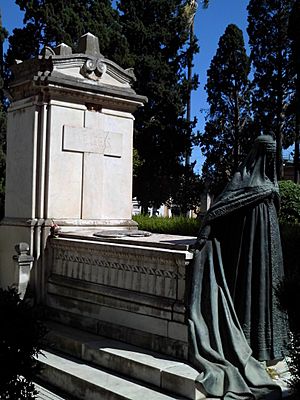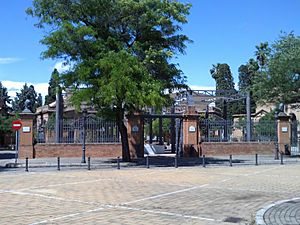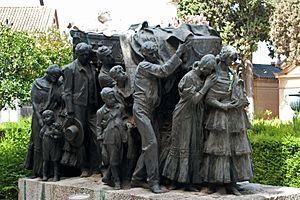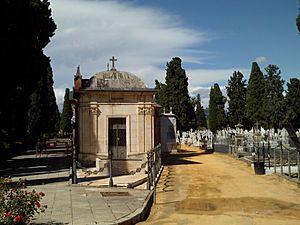Cemetery of San Fernando facts for kids
The Cemetery of San Fernando (Spanish: El Cementerio de San Fernando) is a famous burial ground in Seville, Andalusia, Spain. It is located in the San Jerónimo area, north of the city. This cemetery was built in 1852. It is the only public cemetery for the city of Seville. The cemetery covers a large area of about 28 hectares (about 70 acres). It is known as one of the most important cemeteries in Spain.
Contents
Cemetery Layout
The San Fernando Cemetery has an unusual shape, like a wide triangle. The main entrance is at the southwest corner. From there, a long road stretches for about 800 metres (half a mile). This main road is divided into three parts by two roundabouts.
The first part of the road is 360 metres long. It goes from the entrance to the first roundabout. This section is called Calle de la Fe (Faith Street). The second part is 120 metres long and connects the two roundabouts. It is named Calle de la Esperanza (Hope Street). The final part is 240 metres long and is called Calle Caridad (Charity Street).
Many smaller roads cross the main road. Some of these are named after saints, like St. Rufino and St. Braulio. Near the end, two streets are named after the Virgin Mary and St. Saviour.
History of the Cemetery
Old Burial Customs
Before the 1800s, most people were buried inside churches. Wealthy families had crypts or tombs in the church basements. Poorer people were buried in churchyards or hospital cemeteries. These burial places were usually close to where people lived. However, some cemeteries were built on the edge of towns.
In the late 1700s, a politician named Pablo de Olavide planned new towns in Andalusia. He always included a cemetery outside the town in his designs. This idea of burying people away from homes became more common.
A serious outbreak of yellow fever hit Seville between 1800 and 1801. About 14,000 people died. This led to the creation of a large temporary cemetery near St. Lázaro hospital. This event showed the need for bigger, more organized burial grounds.
Earlier Cemeteries in Seville
The first public cemetery built outside the city walls was the Cementerio de San Sebastián. It was created in the 1820s. People had been buried near the San Sebastián chapel during plague outbreaks in the 1600s. However, the location was not ideal.
In 1819, a group called the San Sebastián Brotherhood built a private tomb there. They hoped to make money from burials. Later, a public tomb with 202 niches (small spaces for coffins) was designed. This work finished around 1828. People could rent these niches for seven years. There was also a large grave for poor people.
However, this cemetery had problems. Bodies were not buried properly, water collected, and it was not well looked after. It became ruined by the 1850s and closed in 1885.
Another cemetery, the Cementerio de San José, was planned in 1832. It opened on March 1, 1833. Even though it was kept in good condition, it was too small to be the main city cemetery. It closed in 1885. The bodies were moved in 1901, and the land was sold. A new neighborhood was built there in 1924.
Building San Fernando Cemetery
The City Council decided to build a large new cemetery for Seville. They chose land in the San Lazaro area, north of the city. In 1851, the architect Balbino Marrón y Ranero presented his plan. He suggested having mostly graves in the ground, with only a few niches for strangers or people without families. He also planned for large family tombs or mausoleums. These could hold 25 to 30 people.
The cemetery was finished in 1852. It was named San Fernando on December 3, 1852. The city council wrote the first rules for the cemetery on December 24, 1852. The cemetery officially opened on January 3, 1853.
Since it opened, people could choose different types of burials based on cost. There were individual graves and larger graves for several people. At the highest level, there were tombs with grand monuments and family mausoleums. Some of these were designed by Balbino Marrón himself.

Important Monuments and Art
In 1861, the city council decided to build a monument for soldiers who died in the African War. José de la Coba Mellado designed a stone monument. It has plaques with the names of the buried soldiers. A relief shows a female figure, representing Victory, crowning a lion. A column topped with cannonballs and a cross stands on the pedestal.
In 1895, the sculptor Antonio Susillo created a bronze crucifix. The city bought it in 1897. It was placed on a rocky mound in 1907. People called it the "Christ of the Honey." This was because honey seemed to come from its mouth in the summer of 1907. It was likely caused by a beehive melting inside the statue due to the heat.
Many famous architects from the early 1900s designed tombs and mausoleums here. Aníbal González designed several, including the pantheon for his own family. This one has a copy of the "Cachorro," a famous crucified figure.
Vicente Traver designed simpler tombs. Antonio Illanes made a tombstone with a cross for the Palomeque family. The bronze monument for the bullfighter Joselito el Gallo was designed by Mariano Benlliure in 1921. It shows people carrying an open casket.
In 1926, Gabino Amaya designed a bronze sculpture for the painter José Villegas Cordero's burial. It shows a large figure in a tunic. Another notable tomb is for Juan Vázquez de Pablo, designed by Antonio Arévalo in 1927. It has a white stone statue of Jesus.
The cemetery also has several funeral chapels. One of the largest was designed by Aníbal González in 1912. It is for Emilia Scholtz and is built in a neo-Renaissance style.
Changes Over Time
In 1932, during the Second Republic, a wall that separated the Catholic cemetery from a section for non-Catholics was ordered to be taken down. This showed a move towards more secular (non-religious) practices. In 1934, new rules for the cemetery removed the chaplain (a priest).
During the Spanish Civil War (starting in 1936), four mass graves were created in the cemetery. Important figures like the Andalusian leader Blas Infante and many other Sevillians were buried there. In 2002, a monument was built in this area. There are eight mass graves in total in the cemetery. They were used from 1852 to the 1960s. Besides the Civil War graves, the others were for homeless people and bodies that were not claimed. About 28,997 bodies are buried in these mass graves.
After the Republican period, the cemetery got its original name back. Improvements were made in the late 1930s and 1940s. In 1940, the remains of the sculptor Antonio Susillo were moved to rest under his famous crucifix statue.
In 1941, it was decided to expand the cemetery to the north. This extension added many new niches. In 1947, Juan Talavera y Heredia designed a modern funeral chapel for the Piarists.
Jewish Burials and Crematoriums
Jewish people began to be buried in the cemetery in 1883. In 1900, a special area of 70 square meters was given to the Jewish community for their burials. In 1949, a wall was built to separate the graves of Protestants from those of Jewish people. However, this wall was taken down by the city council in 2010. This was done as a sign of tolerance and non-discrimination.
The first crematorium (a place to cremate bodies) was added to the cemetery in 1986. A second one followed in 1994. By 2000, buildings for four crematoriums were built near the entrance, though only three were used. The increase in cremations meant that a planned large extension of the cemetery for new niches was not needed.
In 2000, the cemetery was expanded in the southeast area. In 2007, the City Hall added awnings and made other improvements to the main entrance.
Images for kids
-
Mausoleum for the Olave family
See also
 In Spanish: Cementerio de San Fernando (Sevilla) para niños
In Spanish: Cementerio de San Fernando (Sevilla) para niños








